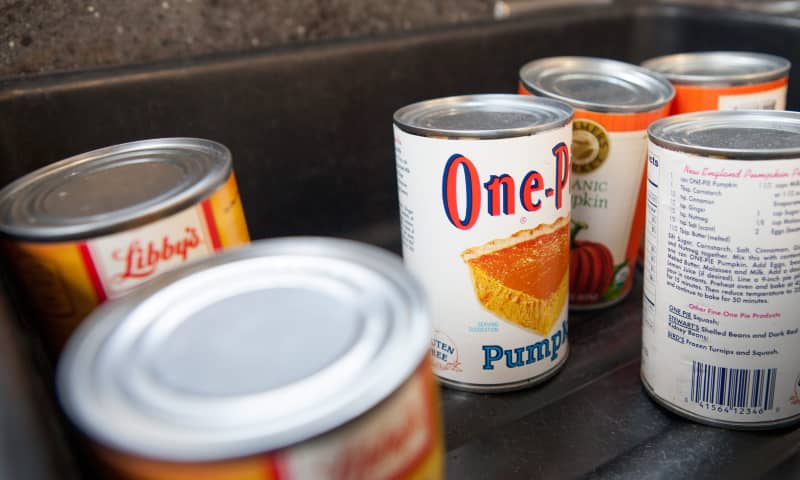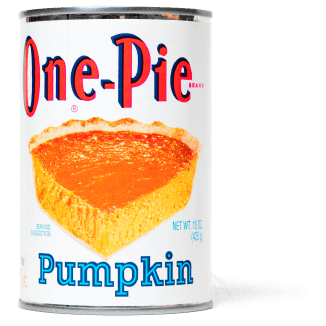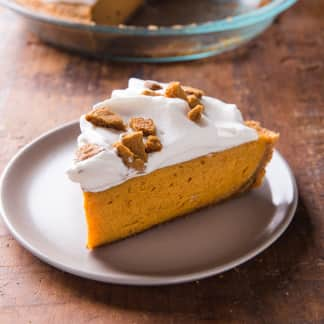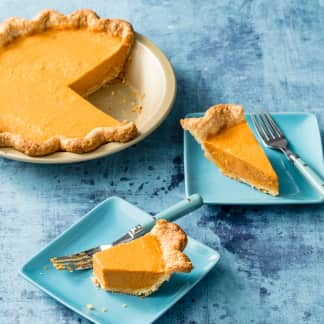Canned pumpkin puree is the nation’s top-selling pumpkin product. Americans rely on it to add a subtle, squashy sweetness and bright orange color to fall favorites like pumpkin pie and pumpkin bread. But does it really matter which product you choose? To find out, we picked three widely available pumpkin purees and had 21 America’s Test Kitchen staffers sample each plain, baked into pumpkin cake, and whipped into our no-bake Rum Pumpkin Chiffon Pie.
We were immediately struck by the drastic visual differences between the samples: Two were bright orange, like we expect from pumpkin, while one was pale and made cake and pie that were shockingly jaundiced and mustard-colored—an immediate turn-off for tasters.
Those who got past the color differences were flummoxed by the variety of textures. The yellow puree was a pulpy paste reminiscent of baby food and made an oddly thick pie filling and an overly dense cake. Another product was prominently fibrous when sampled plain, and though this wasn’t an issue in cake, tasters noted a chalky grittiness in its pie. Nutritional labels showed that these two products had 33 percent more fiber than our top-ranked puree—14 grams versus 10.5 grams per 15-ounce can—which resulted in a thick, unappealing texture. We preferred the smoothness of the pumpkin with less fiber, which made tender cakes and airy, smooth pie filling.


Members of our tasting panel noted considerable differences in different pumpkin purees, whether they tasted them plain, in pumpkin cake, or in Rum Pumpkin Chiffon Pie.
As for flavor, tasters described lower-ranked options as metallic and bitter, while the top-rated product was deemed pleasantly sweet. Here, sugar was the culprit: While lower-ranked purees contained 14 grams of sugar per can and were deemed aggressively squash-like, our top-ranked pumpkin had 17.5 grams of sugar per can and was lightly sweet, with minimal bitterness. In fact, every product had just one ingredient: pumpkin. Clearly, some products were relying on pumpkins with more natural sugar, but what accounted for the drastic color, texture, and flavor differences?

As it turns out, the U.S. Department of Agriculture doesn’t have strict guidelines for what can be labeled as pumpkin. Instead, botanists define pumpkin as any squash with a firm shell, round body, and golden flesh—though many pumpkin varieties lack some of these traits. This explains why the products varied wildly: They’re made from different varieties of pumpkins.
We reached out to manufacturers and learned that our top-ranked product uses Dickinson pumpkins cultivated in Illinois, while the poorest-performing product is made from Golden Delicious pumpkins harvested in Oregon. And though our runner-up is also made from Dickinson pumpkins, each brand uses a proprietary cultivar unique to its product. These differences in variety and climate add up to ensure that no two canned pumpkins are alike.

Our favorite was Libby’s 100% Pure Pumpkin, which tasters praised for its silky consistency and subtle sweetness. Fortunately it’s also the easiest to find: Libby’s makes 85 percent of the world’s canned pumpkin from a special variety of Dickinson pumpkin known for its tender flesh and sweeter flavor. The result is canned pumpkin that makes moist, rich cakes and fluffy, delicate pies.
- Taste plain, scooped directly from can
- Taste baked into pumpkin cake
- Taste whipped into Rum Pumpkin Chiffon Pie
- Scrutinize ingredient labels for sugar and fiber content
- Prominent pumpkin flavor
- Slight sweetness
- Smooth, even texture










